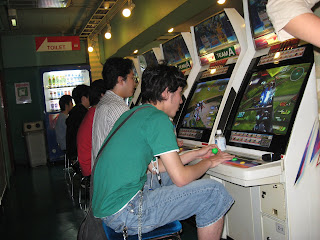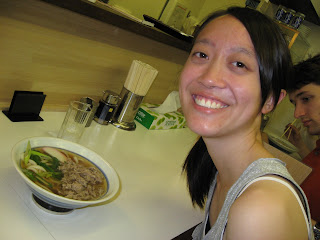Our last full day in Tokyo was pretty free. We went to the fish market this morning, and I have to say I was a little disappointed. I had heard a lot about it, but when we got there, it wasn’t a busy day and I think the busyness normally adds to the atmosphere. The fish market is the first stop for some of the oceans’ best and freshest seafood. Japan consumes most of the fish brought to the market before it’s sent out to the rest of the world.


What I saw was really no different from what I’m used to at Chinese supermarkets, except that it was Japanese. Fishes, crabs, seaweed, wasabi plants. They were all laid out before me at the market, and we mainly just wandered up and down the small market streets before lunch.
At one stop, we saw these little balloon things and curious as we journalists are, we asked the man what they were. He then took a balloon, laid it out on Matt’s hand and then popped it! Inside was this oddly coloured silver mass. It was awkward looking and a little creepy, and the man said it was tofu. So we all took bites out of it, and it really wasn’t that bad, except that it was just weird. We didn’t end up eating the whole thing, but we didn’t let the polite Japanese man know it.
Lunch was a traditional sit-on-the-floor Japanese meal filled with sushi. I was a little skeptical about the tuna because the tuna sushi that I’ve always eaten has always had a weird aftertaste so I’m normally not keen on it. But since I was in Japan, I had to eat it since it was probably just catch 15 minutes ago. And it really was the best tuna sushi I’ve ever eaten! The eel sushi was sweet and tender. The egg sushi was amazing – a light sweet taste with a slightly salty afterthought. But I thought the salmon sushi was the best. It was fresh and slick and sweet.

Then we took a tour of Asahi Shimbun, the world’s second largest newspaper. The world’s first is also in Japan, and most people in Japan subscribe to a paper. The Shibun puts out two editions, a morning one and an evening one. The morning circulation is 8 million and the evening circulation is 3 billion. These are numbers the New York Times dreams about. People in Japan seem to really respect their journalists, much more so than in the States.

Asahi Shimbun has 1250 editorial staff and 3500 staff in total. In their introduction video, the paper showed their reporters as very multi-faceted. Reporters are also photographers, which I thought only just showed how journalists now need to play more than just one role. Just like how broadcast journalists need to know how to blog and take video, print journalists need to be their own photographers.
We spoke with Go Kawasaki, who I believe is a political writer, and Toshiaki Miura, an editorial writer. And through our conversations with them, I learned how the press is so pivotal in Japan. Historically, Japan got freedom of the press from the United States after the US helped democratize the country, and so newspapers are a symbol of the country’s freedom.
However, I was surprised at how journalists at the Asahi Shimbun are not moving toward the Internet. Kawasaki and Miura said Japanese journalists don’t do Internet reporting or blogging because it’s difficult for them to do morning, evening and Internet coverage of their stories. I found this particularly interesting because for such a technologically advanced country that you would expect would embrace new media, their newspapers and journalism are more traditional.
We were then abandoned by Brad and Hiromi and forced to find our way back. Actually it was fun because it was an adventure getting back and it really was a test of our travel skills. After a brief break in the hotel, Deanna and I went to Daimaru, one of Tokyo’s largest department stores and I was in heaven for about half an hour. Their first floor is full of desserts and pastries and I was just floating around from one to another, just trying to decide what to buy. To my delight, there were samples! So let’s just say I wasn’t stingy about those. Their desserts are so decadent but they don’t look too sweet and diabetes-like like American desserts; they seem to be just the right amount of sweet and savoury-ness. In the end, I bought a small pastry and a black sesame mochi with red bean filling.
Later in the evening, Matt, Amanda, Deanna and I went to Tokyo Tower, which is Tokyo’s respond to the Eiffel Tower. We would see it as soon as we stepped off the subway and we pretty much followed the light like the shepherds followed the bright star. We slowly made our way through the district and wound up at the legs of the Tower. It was really bright, not in a flashy sort of way, but just in a general this-is-bright kind of way. We bought our tickets (820 yen) to the observation deck, and though I’ve been to my fair share of towers, I really liked the Tokyo Tower. In most cities, only one section of the Tower’s view will be fully lit but it seemed like in all 360-degrees of the Tower, Tokyo was lit up.

Lights of business buildings and lights of the streets and lights of particular districts, like Shibuya, really seemed to fill up the sky. And in most cities, the lights seem to end after a while and disappear into the dark sky, but in Tokyo, the buildings never seem to end. We all noticed that even if there was a pack of buildings in the skyline, the lights didn’t end there; there were even more buildings behind those ones! The lights just seemed to keep on going and going.



We got back pretty late for our rendez-vous with everyone else and the rest of the night was very uneventful. Our attempts to find a late night dinner place were sadly unsuccessful, and our attempts to find a late night dinner place on the streets was even more difficult and unsuccessful. Needless to say, my last dinner in Tokyo wasn’t that tasty – I had burnt (possibly carcinogenic) chicken wings and untasty ramen.





































